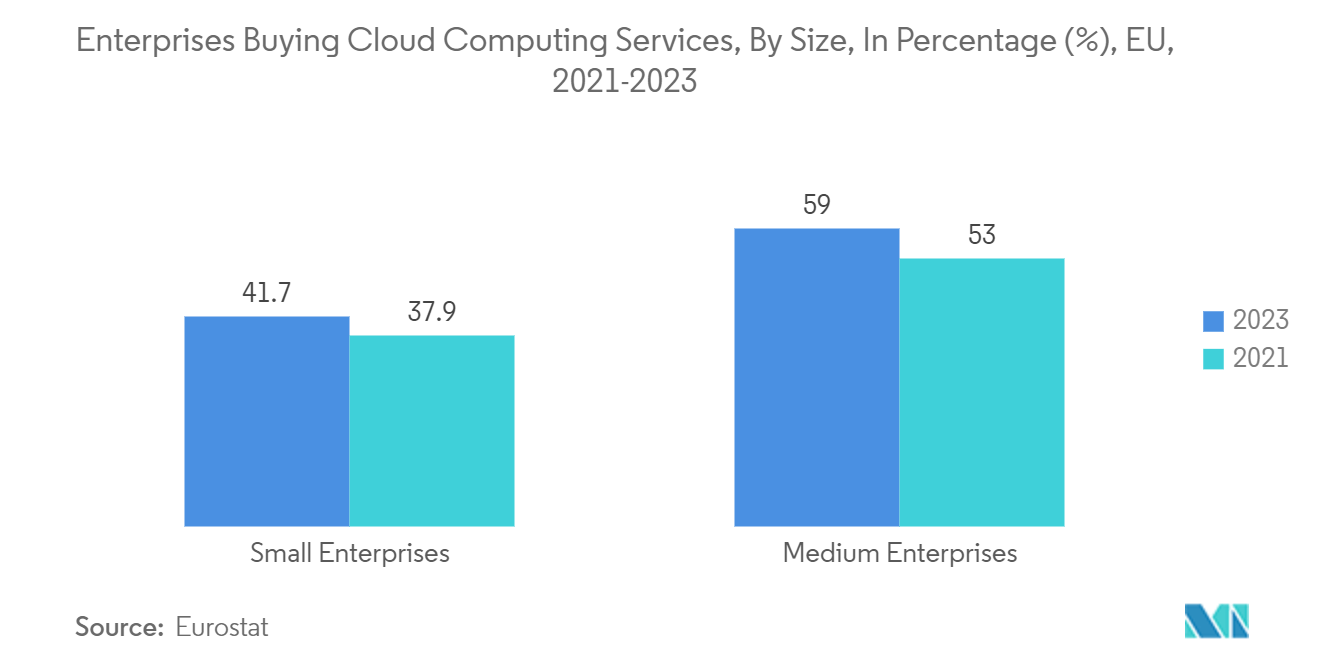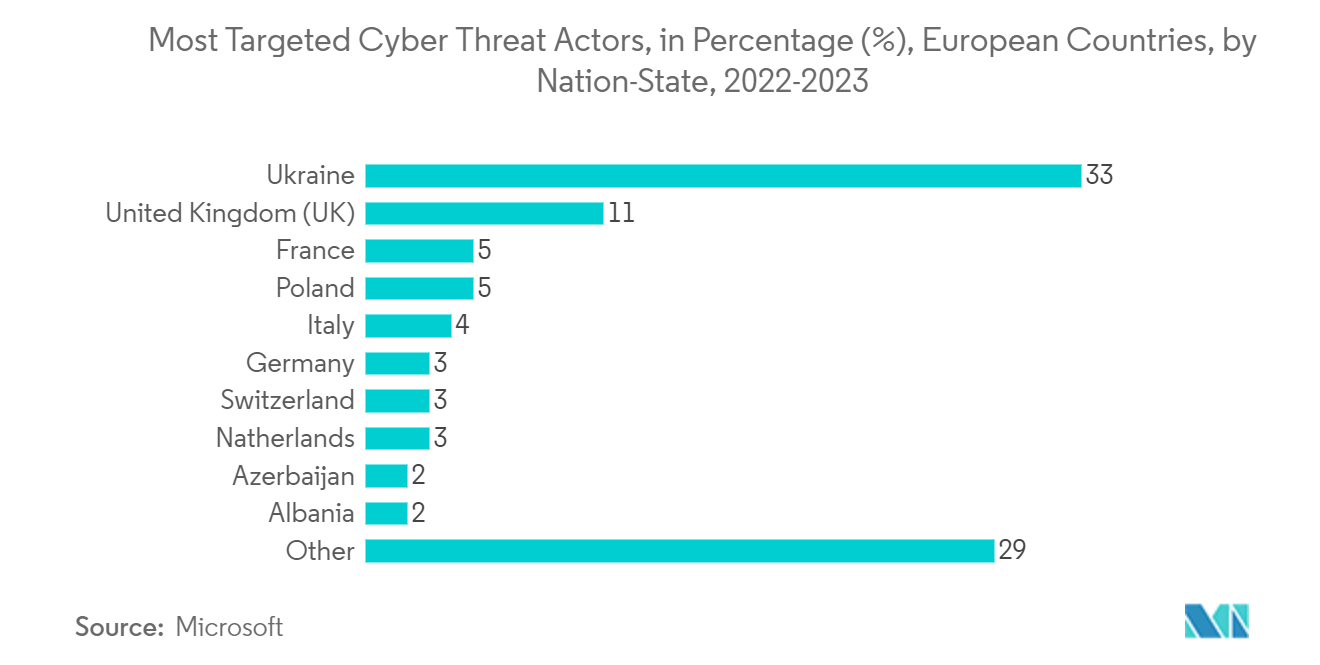Market Trends of Europe SOCaaS Industry
Retail and Consumer Goods to be the Fastest Growing End-user Industry
- Small and medium-sized organizations (SMEs) with less than 1000 employees have become soft targets for cyber threats in Europe. This has increased the demand for the Security Operations Center as a Service (SOCaaS). Thus, SMEs are anticipated to occupy a significant share in terms of organization size in the market studied as they are increasingly implementing a subscription-based SOCaaS model for network monitoring, threat detection, and incident response.
- By outsourcing their security operations to SOCaaS companies, SMEs can save on staffing and training costs, sidestepping the financial burden of establishing and upkeeping an in-house security team. Moreover, European SMEs are increasingly turning to SOCaaS to counter ever-evolving cyberattacks, drawn by benefits such as specialized cybersecurity expertise, cutting-edge technologies, rapid threat detection and response, and the flexibility to scale security operations as required.
- The World Economic Forum's (WEF) 2023 Report states that smaller organizations are more likely not to have measures to identify vulnerabilities in their infrastructures and are more likely to suffer from budget constraints and a lack of trained experts to manage internal risk. This encourages them to follow a security approach where a third party addresses SOC via the cloud.
- In a recent report by the security solution provider Guardz, 57% of SMEs have experienced a cyber threat, with 29% reporting no cyber insurance. With cyberattacks targeting SMEs on the rise, 70% of respondents are confident that their businesses are resilient enough to withstand such threats. However, 44% of respondents believe that their antivirus solution fully protects their business, and 25% of companies admit not regularly training their employees on security monitoring capabilities.
- By the end-user industry, the IT and telecom sector is anticipated to witness increased adoption of SOCaaS in Europe. Rapid IT, AI, Big data, and communication development trigger significant cybercrime interest. According to The International Trade Administration (ITA), Europe, specifically Bulgaria, is a crucial target for cybercrime owing to its advanced Internet infrastructure. Several cities in Bulgaria, including Sofia, Plovdiv, Varna, and Bourgas, host many R&D centers, software development hubs, and shared centers and manage 24/7 international operations, increasing the risk of cyberattacks in Bulgaria.
- The ITA states that there has been an increase in cyber-attacks against Bulgarian businesses, with 57% of Bulgarian organizations subject to cyberattacks once a day or once a month. In November 2023, Bulgaria announced the allocation of USD 2.2 million to help SMEs improve their detection and response to security threats. The initiative may enable the development of a network of national coordination centers, propelling the SOC-as-a-service market demand in the segment.
- In Europe, the increasing adoption of IT and cloud environments, particularly among SMEs, drives the market forward. As organizations manage the complexities of modern IT infrastructures—encompassing cloud, hybrid, and multi-cloud configurations—they face heightened security challenges. This landscape boosts the demand for SOC-as-a-Service. According to Eurostat, in 2023, 59% of medium-sized enterprises had adopted cloud computing services, a notable increase from 53% in 2021. In parallel, the proportion of small businesses utilizing cloud services grew by 3.8 percentage points, reaching 41.7%.

Germany Holds Significant Market Share
- Cybersecurity plays a crucial role in the security operations center landscape in the German portion of the European security operations center (SOC) as a service market. One of Europe’s strongest economies, Germany is committed to improving digital security and safeguarding private data by implementing SOC services.
- Germany has particular network security challenges because it is a hub for many businesses. The foundation of the German economy, the manufacturing sector, is especially open to cyber attacks. Industry 4.0, which refers to the increased interconnectedness of industrial systems, raises concerns about the possible impact of cyber attacks on critical infrastructure.
- For instance, in September 2023, according to the German Digital Association, Bitkom Germany lost EUR 206 billion (USD 224 billion) due to IT equipment and data theft and industrial and digital espionage and sabotage. This will be the third year the damage has exceeded EUR 200 billion.
- The country is witnessing growth in cyberattacks due to the increased interconnectedness of Internet of Things (IoT) devices and digital transformation across industries. To safeguard sensitive data and vital infrastructure in urban settings, SOC services are developing to secure these growing attack vectors. According to Microsoft, around 3 percent of the network intrusions in Germany are by nation-state or state-affiliated cyber threat actors.
- For instance, in November 2023, the Office for Information Security (BSI) in Germany gave a report on cybersecurity and IT in the nation. According to the analysis, the threat level is “higher than ever before,” with an average daily growth in malware types of 332,000 throughout the analyzed period, setting a record for the country.
- In August 2024, Bitkom, a trade association representing Germany's IT sector, unveiled its latest survey findings. The survey revealed that 80% of German businesses faced data or IT theft incidents, industrial espionage, or sabotage over the past year. Notably, 45% of these companies traced the cyberattacks or acts of industrial spying back to China.
- The survey highlighted that Russia was accountable for 39% of the attacks. It's worth noting that this figure for Russia has decreased from 46%, while China's attribution has seen a rise, now standing three percentage points higher than the 2023 survey. The survey estimated that acts of industrial espionage, encompassing cybercrime, cost the German economy a staggering EUR 267 billion (USD 297 billion) over the past year. This marks a significant 29% increase from the previous year's damages.
- Overall, the proliferation of Industry 4.0 and interconnected devices across industries in Germany, rising cyber attacks, and a dedication to ongoing innovation in the cybersecurity sector are all driving significant changes in the German country of the European security operations center (SOC) as a service market.


